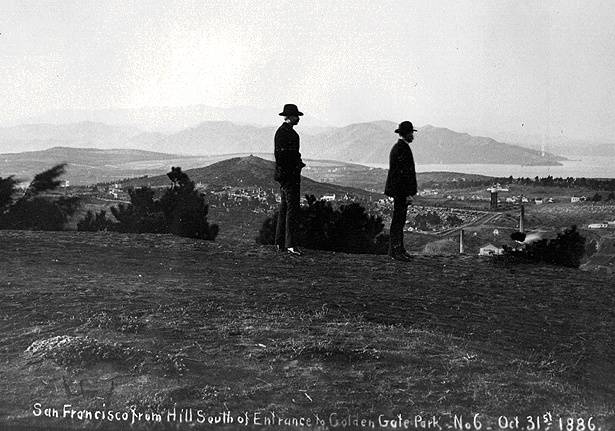LONE MOUNTAIN: Difference between revisions
m (1 revision(s)) |
m (changed captions, credits) |
||
| Line 1: | Line 1: | ||
[[Image:westaddi$buena-vista-and-lone-mtn.jpg]] | [[Image:westaddi$buena-vista-and-lone-mtn.jpg]] | ||
'''Lone Mountain looms behind men (left of the center figure)standing on Buena Vista Heights, with the Golden Gate in distance behind that, October 31, 1886. ''' | '''Lone Mountain looms behind men (left of the center figure)standing on Buena Vista Heights, with the Golden Gate in distance behind that, October 31, 1886. ''' photo: Gaar Collection, San Francisco, CA | ||
The last of the wooden crosses was torn down from the top of Lone Mountain in 1930. And in 1932 construction began on the Spanish Gothic style building for the San Francisco College for Women, Sacred Hearts of Jesus and Mary. A beautiful garden stairway, called the "Spanish Steps" after those in Rome, marks the entrance on Turk Street. This property was acquired by the University of San Francisco in 1978 as an extension to its campus next to St. Ignatius Church. | The last of the wooden crosses was torn down from the top of Lone Mountain in 1930. And in 1932 construction began on the Spanish Gothic style building for the San Francisco College for Women, Sacred Hearts of Jesus and Mary. A beautiful garden stairway, called the "Spanish Steps" after those in Rome, marks the entrance on Turk Street. This property was acquired by the University of San Francisco in 1978 as an extension to its campus next to St. Ignatius Church. | ||
| Line 9: | Line 10: | ||
The Lone Mountain, Laurel Hill, Jordan Park area has changed dramatically over the past 150 years. The sand dunes have disappeared, and the cemeteries are gone. Today the neighborhood is a vibrant residential, commercial, and university community. Although its character will continue to change as time goes on, such monuments as the Pioneer's Memorial Plaque (at the entrance to U.C.'s Laurel Hill campus) and the green-domed Columbarium, if they are preserved, will continue to serve as tangible reminders of the area's past. | The Lone Mountain, Laurel Hill, Jordan Park area has changed dramatically over the past 150 years. The sand dunes have disappeared, and the cemeteries are gone. Today the neighborhood is a vibrant residential, commercial, and university community. Although its character will continue to change as time goes on, such monuments as the Pioneer's Memorial Plaque (at the entrance to U.C.'s Laurel Hill campus) and the green-domed Columbarium, if they are preserved, will continue to serve as tangible reminders of the area's past. | ||
''- | ''- Deanna L. Kastler, excerpted from "Lone Mountain & Laurel Hill: From Necropolis to Residential, Commercial, & University Neighborhoods", originally published in ''The Argonaut'', Vol. 3, No. 1, Winter 1992'' | ||
[[Old Cemeteries in the City |Prev. Document]] [[Harry Bridges Memorial Bldg. |Next Document]] | [[Old Cemeteries in the City |Prev. Document]] [[Harry Bridges Memorial Bldg. |Next Document]] | ||
Revision as of 18:35, 23 June 2008
Lone Mountain looms behind men (left of the center figure)standing on Buena Vista Heights, with the Golden Gate in distance behind that, October 31, 1886. photo: Gaar Collection, San Francisco, CA
The last of the wooden crosses was torn down from the top of Lone Mountain in 1930. And in 1932 construction began on the Spanish Gothic style building for the San Francisco College for Women, Sacred Hearts of Jesus and Mary. A beautiful garden stairway, called the "Spanish Steps" after those in Rome, marks the entrance on Turk Street. This property was acquired by the University of San Francisco in 1978 as an extension to its campus next to St. Ignatius Church.
After the third St. Ignatius Church on Hayes and Van Ness was destroyed by fire in 1906, a new church was begun "as a Jesuit act of faith" on former Masonic Cemetery land at Parker and Fulton. The Neo-Baroque style structure was built between 1910 and 1914 with a tin roof, steel frame, engaged fluted columns of terra cotta, pressed brick walls containing over 250,000 bricks, and 128 clerestory windows. Its twin towers could be seen by ships at sea. The 5,824-pound bell in the campanile had been saved from the church on Hayes and Van Ness.26 Today St. Ignatius is illuminated in the evenings and sits golden in the moonlight on its hill.
The Lone Mountain, Laurel Hill, Jordan Park area has changed dramatically over the past 150 years. The sand dunes have disappeared, and the cemeteries are gone. Today the neighborhood is a vibrant residential, commercial, and university community. Although its character will continue to change as time goes on, such monuments as the Pioneer's Memorial Plaque (at the entrance to U.C.'s Laurel Hill campus) and the green-domed Columbarium, if they are preserved, will continue to serve as tangible reminders of the area's past.
- Deanna L. Kastler, excerpted from "Lone Mountain & Laurel Hill: From Necropolis to Residential, Commercial, & University Neighborhoods", originally published in The Argonaut, Vol. 3, No. 1, Winter 1992

